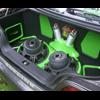Nitrous Purging
Announcements
-
Latest Posts
-
Fuel tank is out. Looks pretty bloody good under (ie above) the fuel tank. Amazing how good the factory e-coat holds up in the hidden areas. No where near as much body deadener to get rid of as the front but still not looking forward to it! Shit of a job. I'm thinking I might grab a needle scaler and give that a go before I attack it with the angle grinder and wire wheel which is how I did the front 2/3's of the car. Feels good to be working on the car again but who knows how long it will last! Hopefully I can get it further forward than where it was prior to this last block of work when I decided to go back 10 steps further down the rabbit hole from where i already was! The problem is, I'm realising how hard it will be to repair and paint the bumpers, which cannot be put back on the car, and have a good paint match. There are also areas where it would be VERY hard to hide the new paint where it transitions from old paint. Like this- There is only one way to do that perfectly and I really dont want to have to do what that means I would have to do... 🤦♂️
-
By joshuaho96 · Posted
Pretty sure the factory assembly doesn't have any gasket at all, just RTV. -
I will get a couple cans for sure thanks, I do have 2lt fish oil to spray around the car already.
-
Thought I’d post pics of the packages for those interested. The premium package is #16. Remote start, security with tilt sensor and remote and backup battery, auto fold mirrors and door illumination. Can post up pics of all the factory options and images from the factory options brochure if people are interested. I have all the dealer books etc for all rv37 models.
-
After its dried out Penetrol is you friend to treat rust and seal up those seams
-



Recommended Posts
Create an account or sign in to comment
You need to be a member in order to leave a comment
Create an account
Sign up for a new account in our community. It's easy!
Register a new accountSign in
Already have an account? Sign in here.
Sign In Now